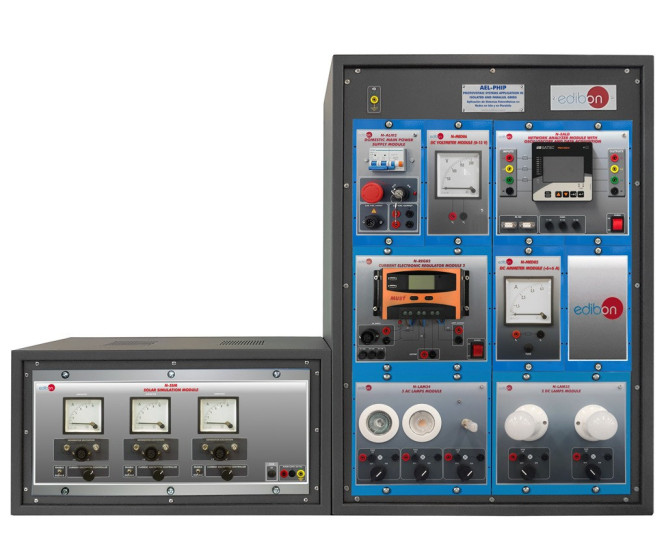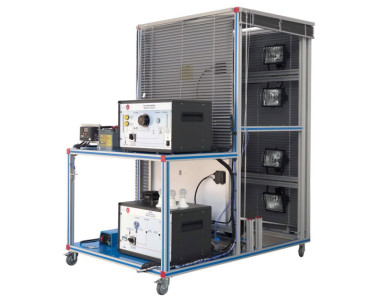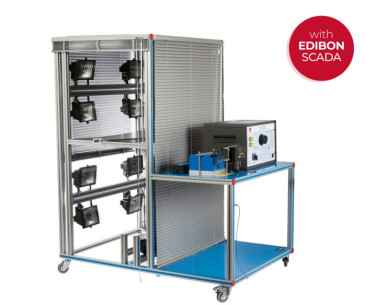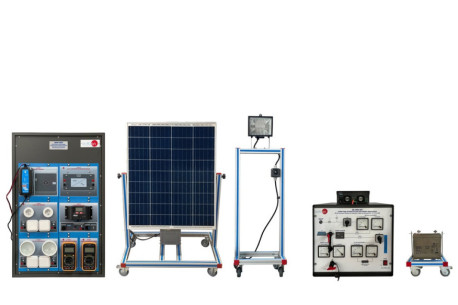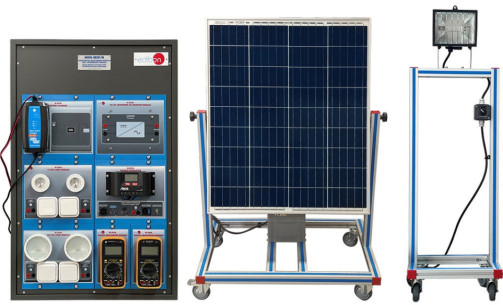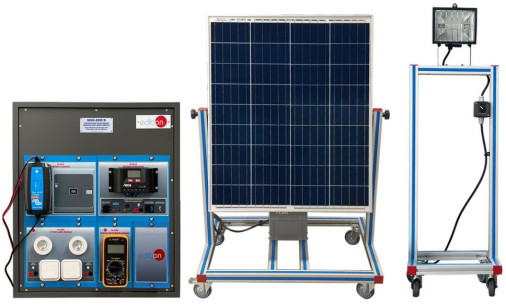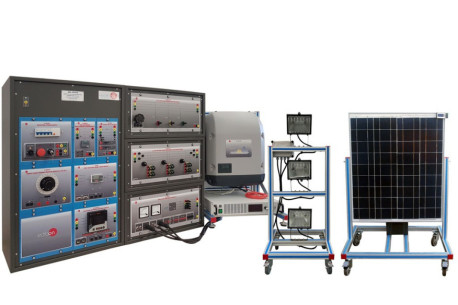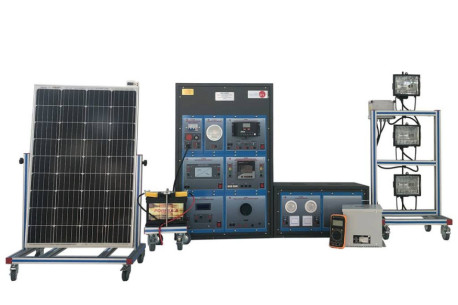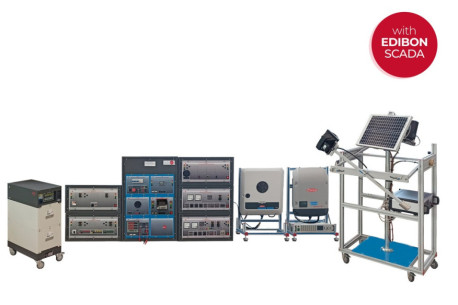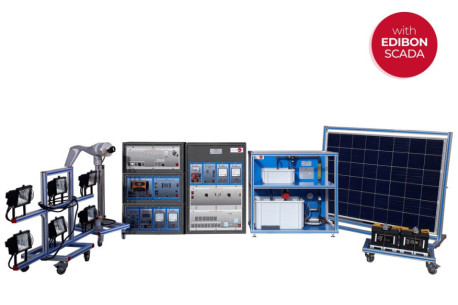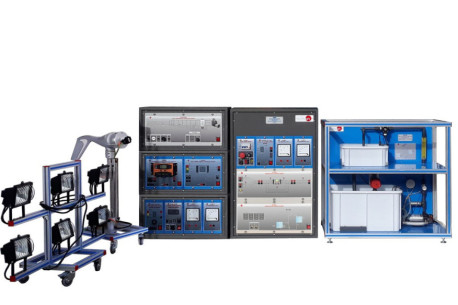L'Application des Systèmes Photovotaïques dans des Réseaux Isolés et Parallèles, "AEL-PHIP", a été conçue par EDIBON pour étudier les opérations effectuées dans les systèmes photovoltaïques qui fonctionnent de manière isolée du réseau national d'énergie (fonctionnement en îlotage) ou connectée à celui-ci (fonctionnement en parallèle).
Cette application permet d'étudier la production d'électricité au moyen de panneaux photovoltaïques, à travers la simulation de différentes configurations et de conditions d'irradiation, ainsi que son fonctionnement en îlotage et en parallèle au réseau. A cette fin, l'application permet également de prouver et de comprendre les principes de fonctionnement des différents types de panneaux photovoltaïques.
A cette fin, l'application "AEL-PHIP" est composée de différents kits permettant d'étudier plusieurs aspects des centrales photovoltaïques :
- PHIP-K1. Kit d'Analyse de Modules Photovoltaïques en Série et en Parallèle.
- PHIP-K2. Kit de Systèmes Photovoltaïques Monophasés Hors Réseau.
- PHIP-K3. Kit de Systèmes Photovoltaïques Monophasés Connectés au Réseau.
L'objectif didactique de chaque kit est détaillé ci-dessous :
- PHIP-K1. Kit d'Analyse de Modules Photovoltaïques en Série et en Parallèle: Ce kit consiste en un module photovoltaïque assemblé sur une structure sur roues qui permet de varier l'angle d'inclinaison du module solaire. Ainsi, il est possible de simuler différentes inclinaisons de toits ou structures typiques, au-dessus desquelles ces modules photovoltaïques sont installés. Une lampe halogène montée sur un bras articulé est couplée à la structure mentionnée pour la simulation de la course du soleil. La lampe est équipée d'un régulateur de courant qui permet de contrôler l'irradiation incidente sur le panneau photovoltaïque. Pour simuler la charge du panneau solaire, le kit comprend une charge résistive variable.
- Ce kit comprend également un module de simulation solaire composé de trois simulateurs de panneaux photovoltaïques, qui permettent de travailler sans la lampe halogène. Chaque simulateur de panneau dispose d'un régulateur pour le réglage de l'irradiation solaire et d'un voltmètre et d'un ampèremètre analogiques pour la mesure de la production électrique.
- Grâce à ce kit, l'utilisateur pourra réaliser les apprentissages suivants : affichage des courbes journalières et annuelles, calcul de la position optimale des modules photovoltaïques, affichage des courbes caractéristiques et analyse des modules photovoltaïques en parallèle, en série et autres configurations.
- PHIP-K2. Kit de Systèmes Photovoltaïques Monophasés Hors Réseau: Ce kit est composé de tous les éléments industriels nécessaires pour étudier et comprendre le fonctionnement d'un système photovoltaïque réel qui fonctionne en mode îlot. Tout d'abord, il comprend un régulateur électronique dont le but est de contrôler le flux de charge de la batterie et le flux de puissance d'entrée de l'onduleur. En outre, ce kit comprend un onduleur à onde sinusoïdale qui transforme le CC provenant du régulateur en CA monophasé. Aux sorties du régulateur et de l'onduleur, on connecte respectivement des charges CA et CC, dont le but est de consommer l'énergie générée. Ces charges sont des lampes CA et CC avec une consommation d'énergie différente. Ce kit comprend également un analyseur de réseau pour le contrôle des paramètres électriques du système ainsi qu'un voltmètre et un ampèremètre analogiques dans le but de les connecter aux bornes de la batterie pour mesurer son courant et sa tension de fonctionnement.
- Avec ce kit, l'utilisateur pourra réaliser les apprentissages suivants : installation de systèmes photovoltaïques, mesure des paramètres électriques de l'installation, conception et exploitation de systèmes photovoltaïques isolés du réseau en fonctionnement direct ou en stockage.
- PHIP-K3. Kit de Systèmes Photovoltaïques Monophasés Connectés au Réseau: Ce kit est composé des éléments industriels nécessaires pour étudier et comprendre le fonctionnement des systèmes photovoltaïques qui fonctionnent en mode parallèle au réseau. À cette fin, il comprend un onduleur industriel qui fournit au réseau l'énergie produite. Le réseau est représenté par l'alimentation électrique incluse dans l'unité de base. L'onduleur de réseau surveille la tension, le courant et l'impédance du réseau pour une déconnexion d'urgence en cas de déviations ou de défauts pouvant être dangereux. Ce kit comprend également un analyseur de réseau pour surveiller les paramètres électriques du flux de puissance fourni au réseau.
 Préférences sur les cookies
Préférences sur les cookies

